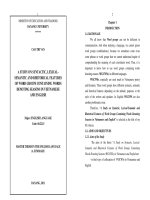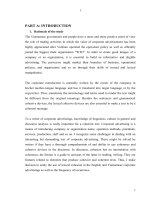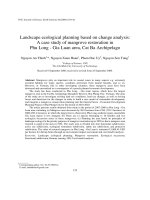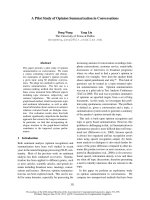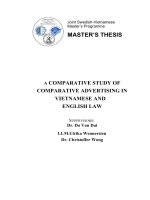a comparative study of comparative advertising in vietnamese and english law
Bạn đang xem bản rút gọn của tài liệu. Xem và tải ngay bản đầy đủ của tài liệu tại đây (368.25 KB, 70 trang )
Joint Swedish-Vietnamese
Master’s Programme
MASTER’S THESIS
A COMPARATIVE STUDY OF
COMPARATIVE ADVERTISING IN
VIETNAMESE AND
ENGLISH LAW
SUPERVISORS:
Dr. Do Van Dai
LLM.Ulrika Wennersten
Dr. Christoffer Wong
Preface and Acknowledgements
The idea for this thesis comes to me when I made a report on a Business Law subject
in the Joint Swedish - Vietnamese Master Programme. Based on materials on U.K
and EU Advertising laws, I realized that there are many differences in points of view
and law between Vietnam and these countries regarding Comparative advertising.
While Vietnamese legislators are still suspicious of the benefits brought by
Comparative Advertising, it is encouraged in E.U as it can can provide useful
information for consumer and enhance fair competition between undertakings. From
various standpoints, it is easy to understand why the law related to Comparative
advertising is set up in different ways. In the internationalized context, when the
promotion of goods and services is not restricted to a single nation, how to establish
legal rules compatible with a common tendency based on the harmonization of the
interest of undertakings and those of consumers is an issue worth concerning.
For helping me complete this thesis, I extend my deepest thanks to my professors,
my friends and my colleagues for their support, help and love. I would like to express
my heartfelt gratitude to my supervisors, Dr.DoVan Dai and Ms.Ulrika Wennersten,
who supported and gave me valuable comments and suggestions during my work. I
am grateful to Dr. Christoffer Wong for his guidance and help throughout the course.
I would also like to express my special thanks to the professors in the Law faculty
of Lund University and the professors of Ho Chi Minh Law University for sharing
their precious knowledge with me. Finally, I would like to thank my friends and my
colleagues for supporting and encouraging me throughout my study.
Although I tried my best, many deficiencies and shortcomings are still to be found
in my thesis. I am grateful for any comments and suggestions.
Ho Chi Minh city, December 2008
1
Table of Contents
Preface and Acknowledgements 1
Table of Contents 2
Abbreviations 4
Executive Summary 5
1.
1.1
1.2
1.3
1.4
2.
2.1
2.1.1
2.1.2
2.1.3
2.2
2.2.1
2.2.1.1
2.2.1.2
2.2.2
2.2.3
3.
3.1
3.1.1
3.1.1.1
3.1.1.2
3.1.2
3.2
3.2.1
3.2.1.1
3.2.1.2
3.2.2
3.3
4.
4.1
4.1.1
Introduction 6
Rationale 6
Purpose 6
Methods 7
Delimitation 8
The definition of comparative advertising 8
The general definition of advertising 8
The definition of advertising in English law 9
The definition of advertising in Vietnamese law 12
Comparative remarks 15
The definition of Comparative Advertising 16
The definition of comparative advertising in English laws 17
Definition and classification 17
Analysing the definition of Comparative Advertising 19
The definition of Comparative Advertising in Vietnamese law 22
Comparative remarks 24
Lawful comparative advertising 25
Lawful comparative advertising in English law 25
Conditions for comparative advertising to be lawful in English law 25
Negative conditions 27
Positive conditions 36
General remarks 40
Lawful comparative advertising in Vietnamese law 41
Conditions for comparative advertising to be lawful under
Vietnamese law 41
General conditions 42
Special conditions 44
General remarks 46
Comparative remarks 46
Sanctions applied for unlawful comparative advertising 48
Sanctions applied for unlawful comparative advertising in English law 48
The enforcement authorities in English law and practice 48
2
4.1.2
4.1.2.1
4.1.2.2
4.1.2.3
4.2
4.2.1
4.2.2
4.2.2.1
4.2.2.2
4.3
5.
Sanctions applied to unlawful comparative advertising 49
Disciplinary Sanctions 49
Administrative Sanctions 50
Civil sanctions 50
Sanctions applied to unlawful comparative advertising in Vietnamese law 52
Enforcement authority 52
Sanctions 53
Administrative sanctions 53
Civil sanctions 53
Comparative remarks 54
Conclusion 55
Table of Statutes and other Legal
Instruments 57
European Community
Directives 57
1. Council Directive 84/450/EEC of 10 September 1984 relating to
the
approximation of the laws, regulations and administrative
provisions of the
Member States concerning misleading advertising O.J No.
L 250,
19/09/1984 p.17 –
20. 57
National
Legislations
58
England 58
Vietnam 58
Table of
Cases
60
Court of Justice of the European
Communities 60
English
Case
60
Bibliography
61
Official Reports and other
Documents 61
Monographs
62
Articles in Journals, Anthologies
etc. 64
3
Abbreviations
ASA
BCAP
BPRs
CAP
CPRs
ECJ
EU
MCAD
Ofcom
OFT
Radio Code
The CAP code
The CMRs
TMA
TSS
TV code
UK
Advertising Standards Authority in the UK
Broadcasting Committee of Advertising Practice in the UK
Busines Protection from Misleading Advertising
Regulations 2008 of the UK, SI 2008/1276
Committee of Advertising Practice in the UK
Consumer Protection from Unfair Trading Regulations
2008 of the UK, SI 2008/1277
Court of Justice of the European Communities
European Union
Misleading Comparative Advertising Directive
Office of Communications in the UK
Office of Fair Trading in the UK
Radio Advertising Standards Code of the UK
The British Code of Advertising, Sales Promotion and
Direct Marketing 11th edition, March 4th 2003
The Control of Misleading Advertisements Regulations
1988 (amended 2000, 2003)
Trade mark Act 1994 of the UK
Trading Standards Service
Television Advertising Standards Code of the UK
United Kingdom
4
Executive Summary
Comparative advertising is a sales promotion method that compares one’s own goods
or services with those of another trader to emphasize price, value, durability or quali-
ty.1 In the UK, comparative advertising is regulated in three ways: self–regulation;
the common law and statute law.2 Accordingly, comparative advertising is lawful if
it complies with some fairly obvious conditions e.g. it is not misleading, does not
denigrate the competition, objectively compares material, relevant and verifiable
features of the competitor’s products. In Vietnam, comparative advertising is regu-
lated by the Law on commerce, the Law on competition and the Ordinance on Ad-
vertising. Nevertheless, the legal provisions on comparative advertising in Vietnam
are unclear and hard to apply in practice. Thus, this leads advertisers as well as the
competent authority into difficulties when determining whether an advertisement is a
comparative one or not and in drawing the line between lawful and unlawful com-
parative advertising.
The first part of this thesis contains some general issues concerning the rationale,
purpose, delimitation, and methodology of the thesis. The second part introduces,
analyses and compares the definitions of advertising and comparative advertising in
Vietnamese and English law. The third part discusses the conditions for lawful ad-
vertising in each of the two countries. Legislation, case law and practice are analysed
to produced a clear picture. Sanctions applied to unlawful comparative advertising
will be presented and analysed in part four. Based on the method of comparison, re-
marks at the end of each part will point out the similarities and differences between
the issues in the laws of the two countries and suggest some improvements related to
comparative advertising in Vietnamese law. Finally, part five will be a summary of
the previous parts.
L.Bently and B. Sherman, Intellectual property,2nd ed.,Oxford University Press 2004, p.916.
Ansgar Ohly and Michael Spence, The law of Comparative Advertising:Directive 97/55/EC
in the United Kingdom and Germany, Hart Publishing 2000, p.5.
5
1.
1.1
Introduction
Rationale
Advertising plays a very important role in the competitive
strategy of many under-
takings3 since advertising not only notifies customers of
goods and services but also
encourages, attracts and orients them in their purchases.
Comparative advertising, as
a special form of advertising, is also a sales promotion
device that compares the
products or services of one undertaking with those of
competitors.4 It can be a useful
source of information to the consumer, as well as an
important tool in promoting
competition.5 Thus, most countries have permitted
comparative advertising. The UK
was one of the first countries in the EU to permit
comparative advertising if it com-
plies with some provided conditions.
In Vietnam the current legal provisions on comparative
advertising are vague and
incomplete. In fact, a definition of comparative advertising
as well as the way of dis-
tinguishing between direct and indirect comparative
advertising - which is very im-
portant for determining the legality of comparative
advertising - have not yet been
provided by the law. It is in fact necessary to set up some
specific legal provisions
concerning comparative advertising in Vietnamese Law.
Based on these legal provi-
sions, undertakings will be able to determine the boundary
between lawful and
unlawful comparative advertising and adjust their
advertising activities appropriately.
This would enhance fair and equal competition between
undertakings. From these
reasons along with my own interest in it, I have chosen the
topic “A comparative
study of comparative advertising in Vietnamese and
English law” for my thesis.
1.2
Purpose
By researching
comparative
advertising in
Vietnamese and
English law, this
thesis
will analyse and
compare the
definitions of
advertising and
of comparative
advertis-
Julian Petley,
Advertising:Technology,People,Proc
ess, BlackRabbit Books publishing,
2004
p.5.
atgl
e.com.vn/books?
id=aREzFOQ9jsC&
printsec=frontcover
&dq=%22+advertisi
ng
%22&sig=ACfU3U
2oAabErVdot9cOW
mtSWD_MZs8GoQ
#PPA3,M1.
As the BPRs states "Comparative
Advertising means advertising which
in any way, either
explicitly or by
implication,
identifies a
competitor or
product offered by a
competitor."
Theo Bodewig, “The regulation of
Comparative Advertising in the
European Union”, 9 Tu-
lane European &
Civil Law Forum,
1994, 179-214, at
p.185. Also see
Samia M.
Kirmani,“Cross-
boder Comparative
Advertising in the
European Union, 19
Boston College
International &
Com-
parative Law Review, No.1, 1996, 201-215, at p.201.
6
Fel! Använd fliken Start om du vill tillämpa Heading 1 för texten som ska visas
här.
ing and point out the similarities and differences in the definitions in two countries.
Moreover, this thesis will present and analyse the conditions of lawful comparative
advertising in both Vietnamese and English law through legislation, case law and
practice to review the similarities and differences in the rules of legal comparative
advertising under Vietnamese and English law. In addition, it will evaluates and
compare the sanctions applied to unlawful comparative advertising. Finally, the the-
sis will suggest some ways of improving the provisions on comparative advertising
in Vietnamese law.
1.3 Methods
In the process of writing this thesis, several methods such as description, synthesis,
analysis, interpretation and especially comparison were used. The descriptive and
synthetic methods6 were used to collect all materials on comparative advertising and
to give the main contents of the provisions on comparative advertising in Vietnamese
and English law. In addition, based on the analytic method, fundamental concepts
and conditions concerning the legality of comparative advertising in Vietnamese and
English law will be examined. The comparative method, a study of the relationship
between the laws of more than one country, is not limited to comparing legal rules
but requires comparing the relevant non- legal (political, economic, ethical,
religious, ect.) aspects of the two countries as well7. It can lead to a better
understanding of Vietnamese laws on comparative advertising. In addition, the
comparative method can help us to find out the similarities and differences in the
laws related to comparative advertising and explain why these differences or
similarities exist. Moreover, after having compared how to Vietnamese and English
law deal with the laws of comparative advertising, we can evaluate the solution used
in Vietnamese and English law in order to determine which of them is the best one.8
Finally, based on comparative method, the good legal rules of comparative advertis-
ing developed in English law can be implemented to Vietnamese law.9
The descriptive method is a way of presenting and explaining provisions and cases, and the
synthetic method is a process by which we collect materials and combine them together resulting
in the formation of something new.
Michael Bogdan, On the value and method of rule- comparison in comparative law, in
Heinz – Peter Mansel, Thomas Pfeiffer, Herbert Kronke, Christian Kohler, Rainer Hausmann,
Festschrift fur Erik Jayme, Sellier. European Law Publishing 2004, p.1239.
Ibid. p.1240.
Although I am aware that other factors can be used in comparing two legal systems, in this
thesis I do not have enough time to examine geography, climate and racial development or, relig-
7
A Comparative Study of Comparative Advertising in Vietnamese and English law
1.4 Delimitation
My research is limited to English law and Vietnamese law. Further, the UK law is
based on EU Directives, therefore, this thesis also will examine these Directives re-
lated to comparative advertising as well as cases from the ECJ interpreting of the
Directives. Moreover, special rules applicable to comparative advertising related to
certain goods or service such as medicinal products or solicitors are beyond the scope
of this thesis. In addition, it does not mention criminal sanctions but concentrates on
civil and administrative sanctions.
2.
2.1
The definition of comparative advertising
The general definition of advertising
Advertising originated from the word “adverture” in Latin language means attrac-
tiveness, charm and allurement.10 According to the Vietnamese dictionary, Advertis-
ing means “propagandize, introduce goods, services or undertakings to consumers in
many way with the purpose of persuading them to buy these goods or services and
thus promote the goods and services”.11 According to the Oxford dictionary, adver-
tising is drawing attention to or describing favourably (goods or services) in a public
medium to promote sales or making them generally or publicly known, or seeking by
public notice to make them so known.12 Advertising is a paid form of a nonpersonal
message communicated by business firms, non-profit organizations, or individuals
and is transmitted to a target audience through mass media such as television, radio,
newspapers, magazines, direct mail, outdoor displays or mass - transit vehicles13 The
ion. I focus on the statutory, case law and preparatory and secondary sources such as articles and
books.
10
Truong Dai Hoc Luat Ha Noi, Giao trinh Luat Thuong Mai Viet Nam tap 2 (Text book on
Vietnamese Commercial Law volume 2 by the Law College of Hanoi), Cong An Nhan Dan Pub-
lishing 2006, p.151. Also see Nguyen Thi Dung, “Khai niem quang cao trong phap luat Viet Nam
và anh huong của no đen viec hoan thien phap luat ve quang cao” (The definition of advertising
in Vietnamese law and its influences on improving law on advertising), 12 State and Law Jour-
nal (2005), pp.33- 37, at p.33.
11
Nguyen Nhu Y, Đai Tu Dien Tieng Viet (Great Vietnamese Dictionary),Van Hoa Thong
Tin Publishing 1998, p.1365.
Oxford Dictionary of current English, Oxford University Press 1993, at p.12.
/>8
Fel! Använd fliken Start om du vill tillämpa Heading 1 för texten som ska visas
här.
main objectives of advertising is14 informing and persuading consumers to purchase
specific brands offered by the advertisers, thereby getting profits.15 However, adver-
tising is also used to inform, educate and motivate the public about non-commercial
issues, such as AIDS, political ideology, energy conservation, religious recruitment,
deforestation and charity.16 Thus, as far as language alone is concerned, the notion of
advertising not only covers the giving of information about goods and services to
promote sales but also its use to inform, propagandize and motivate the public re-
garding social and cultural life.
2.1.1
The definition of advertising in English law
In the UK, advertising is regulated through self-regulation, case law and statutes.
Self-regulation which has a long tradition in U.K commerce,17 plays an essential role
in advertising.18 The most important element of this self-regulation is the code of
advertising, the CAP code.19 It lays down standards for non-broadcast advertise-
ments, sales promotions and direct marketing communications. This code reflects the
principles of the International Code of Advertising and Practice issued by the Inter-
national Chamber of Commerce20 The code is monitored by The Committee of Ad-
vertising Practice (CAP). Although the code does not provide a definition of adver-
tising, it does lay down the scope of the regulation of advertising activities. Pursuant
to this code, statutory, public, police and other official notices/information, produced
by public authorities and the like as opposed to marketing communications, are out-
side its scope.21
14
Armand Dayan, Le marketing (translated into Vietnamese by Do Duc Bao), Ho Chi Minh
City publishing 2001 p. 8 (Originally publishing by Presses Universitaires de France 1985).
1 5
Monle Lee, Carla Johnson, Principles of Advertising: A Global Perspective, The Haworth
Press Publishing 2005, p. 3.
/>The first voluntary codes were introduced to regulate some professions at the end of the 19th
century: see L. Brandmair, Die Freiwillige Selbstkontrolle der Werbung, Carl Heymanns publish-
ing 1978, p. 35.
G. Miracle and T.R. Nevett, Voluntary Regulation of Advertising, D.C Heath and Company
publishing 1987, p.1.
British Code of Advertising, Sales Promotion and Direct Marketing 11th version 2003.
Ohly & Spence, supra note 2, p.6.
British Code of Advertising, Supra note 19, Art 1.2 (f).
9
A Comparative Study of Comparative Advertising in Vietnamese and English law
In relation to broadcasting advertising, the BCAP TV Code22 and The Radio
Code23 set out the rules that govern advertisements on television and radio respec-
tively. According to TV Code, advertising means “any publicity by advertisers in
breaks during or between programmes. This is irrespective of whether payment is
made.”24 From this definition as well as from the regulations in the code, we can
conclude that it regulates not only advertising related to commerce but also advertis-
ing concerning religion, faith, philosophies, beliefs25 and charity.26 The code applies
to undertakings which use advertising to promote their business as well as to any
other relevant organisation or individual. The Radio Code states “Advertising refers
to any items, including spot advertisements and promotions with advertisers, which
are broadcast in return for payment or other valuable consideration to a licensee or
which seek to sell to listeners any products or services.27 This definition seems nar-
rower than the one in TV Code as it is restricted to paid broadcasting advertising for
the purpose of selling goods and services to listeners. Yet, the regulations of this
code state that advertising is not only used to promote the commercial activities of
undertakings but also to solicit donations by organisations28 and related to religion,
systems of belief or philosophies of life.29
According to the Town and Country Planning Act (Control of Advertisements)
Regulations 1992 and the Town and Country Planning Act 1990, “advertisement
means any word, letter, model, sign, placard, board, notice, awning, blind, device or
representation, whether illuminated or not, in the nature of, and employed wholly or
partly for the purposes of, advertisement, announcement or direction.”30
The UK is a member of the EU. Thus, advertising activity is also regulated by the
regulations which is enacted to implement the EU Directive regulating advertising
into national law. With the purpose of unifying the European common market, har-
Television Advertising Standards Code November 2004 (The Code is an updated edition of
the 2002 ITC Advertising Standards Code.)
2 3
Radio Advertising Standards Code November 2004 (The Code is an updated edition of the
former Radio Authority’s advertising and Sponsorship Code).
Television Code, supra note 22 , Introduction (g).
Ibid Article 10.1.
Ibid Article 11.3.
Radio Code, supra note 23, section 1.
Ibid, section 3, rule 2.
Ibid section 3, rule 3.
The Town and Country Planning Act 1990, section 336(1).
10
Fel! Använd fliken Start om du vill tillämpa Heading 1 för texten som ska visas
här.
monising the laws of its Member States and protecting the economic welfare of con-
sumers by acting against unfair competition, the EU has adopted many directives
concerning advertising e.g. Directive 89/552/EEC concerning the pursuit of televi-
sion broadcasting activities31, Directive 97/36/EC32 amending Directive 89/552/EEC,
Council Directive 84/450/EEC concerning misleading advertising (Directive
84/450/EEC),33 Directive 97/55/EC of European Parliament amending Directive
84/450/EEC concerning misleading advertising so as to include comparative adver-
tising (Directive 97/55/EC)34 and Directive 2006/114/EC of the European Parliament
and the Council concerning misleading and comparative advertising (Directive
2006/114/EC).35According to Directive 84/450/EEC “advertising” means the making
of a representation in any form in connection with a trade, business, craft or profes-
sion in order to promote the supply of goods or services, including immovable prop-
erty, rights and obligations36. Directive 2006/114/EC, which repeals Directive
84/450/EEC, also provides the same definition of advertising at article 2(a). Thus, the
advertising regulated in these directives is mainly that used by undertakings to pro-
mote their business.
The UK has enacted The CMARs 1988 (amended 2000, 2003)37to transpose Di-
rective 84/450/EEC into its national law and enacted The BPRs38 to implement Di-
rective 2006/114/EC. Pursuant to the BPRs, “advertising” means any form of repre-
sentation which is made in connection with a trade, business, craft or profession in
order to promote the supply or transfer of a product.”39 “Product” in BPRs means any
goods or services and includes immovable property, rights and obligation.40 so the
definition of advertising in BPRs is the same as that in Directive 2006/114.
O.J No. L 298, 17/10/1989, p.23.
O.J No. L 202, 30/07/1997, p.60.
O.J No. L 250 , 19/9/1984, p. 17 – 20.
O.J No. L290, 23/2/1997, p.18- 23.
O.J No L376, 27/12/2006, p.21- 27.
Dir 84/450, Supra note 33, Article 2.
The Control of Misleading Advertisements Regulations 1998 (amended 2000,2003), SI
1988/915. This regulations regulated business to business relations and business to consumers
relations in misleading and comparative advertising but it is now invalid.
The Busines Protection from Misleading Advertising Regulations 2008, SI 2008/1276.
Ibid Part 1.2 (1).
Ibid.
11
A Comparative Study of Comparative Advertising in Vietnamese and English law
The definition of advertising is also covered in the case Richard Butler v Derby
City Council.41 The claimant displayed a banner in the front elevation of his property
with the phrase “Save Five Lamps” in red capital letters and below this appeared the
logo, telephone number and website of the “Derby Heart” organisation. The judge
held that a banner is an advertisement if it is “in the nature of and employed, wholly
or partly for the purpose of, advertisement, announcement or direction ”. The Derby
Heart logo and the blue lower- case lettering giving its telephone number and website
were advertising the existence of Derby Heart. It matters not whether, when com-
bined with the words “Save Five Lamps”, the logo and lettering are regarded as be-
ing in the nature of (and for the purpose of) an advertisement for Derby Heart and
one of its aims, or as an announcement of its existence and one of its aims, or as a
direction to those who might wish to support one of its aims.42 The court affirmed
that the banner fell within the extended definition of advertisement in section
336(1).43 According to this, the definition of advertisement is clearly intended to
have a wide meaning, covering not only materials which promote a product or ser-
vice but also an announcement or direction publicizing the activities of a non-
commercial organization.
In short, in English law, definitions of advertising can be found in regulations,
statutes and case law. Based on the purpose and the applicable entities of each code,
regulation or statute, advertising can be understood in a broad or narrow sense. In the
narrow sense, advertising is the making of a representation in connection with trade
to promote the supply of goods or services. In its broader sense, it covers not only the
making of representations about goods or service in public to promote sales but also
any announcement or direction about the activities of non-commercial organisations
such as charities or religious organisations.
2.1.2
The definition of advertising in Vietnamese law
In Vietnam, advertising has been prominent for some time.44 In the years of imple-
menting the Centrally Planned Economy, advertising was not a concern of business
Case Richard Butler v. Derby City Council [2005] EWHC 2835 (Admin).
Ibid paragraph 29 of the judgement.
Ibid paragraph 30 of the judgement.
In the book “Thương hoc phương cham”(Guideline on commercial studies) in 1928 by Lu-
ong Van Can, it states that if a trader would like to increase the number of his consumers, to de-
velop business, advertising should take place as it has much power. Thus, to make advertise-
ments, it should not be regretted that it costs much money. Also see, Le Tai Trien, Luat Thuong
Mai Viet Nam dien giai (Interpretation on Vietnamese Commercial law) Vo.1, Kim Lai Publish-
ing 1976, p. 32.
12
Fel! Använd fliken Start om du vill tillämpa Heading 1 för texten som ska visas
här.
entities because at that time the need to promote goods and services as well as com-
petition between undertakings seem nonexistent. When Vietnam changed the country
from one having a Centrally Planned economy to one with a market economy with a
Socialist Orientation45, advertising become a vital promotional tool frequently used
by business entities. From 1990 on, legal documents regulating advertising have been
enacted.46 One of the important of these is Decree No.194 /CP on the 31st of Decem-
ber, 1994 of the government on advertising activities on Vietnamese territory.47 Ac-
cording to this Decree, advertising activities comprise the presentation of announce-
ments regarding businesses, commodities, services, trade-marks, names and logos as
required by the activities of the production-business-service establishments.48 It is
also affirmed that the information activities of the agencies of the Party and State
aimed at disseminating and popularizing their policies, undertakings and laws are not
covered by this Decree. The definition of advertising in this Decree is thus a narrow
one. The advertising only aims to cover businesses, commodities, services, trade-
marks, names and logos. Information in the form of announcements, messages or
classified advertisements is not considered as advertising.
Advertising activities are currently regulated by two main groups of legal norms.
The first is legal documents drafted or enacted by the Ministry of Culture and Infor-
mation49 which include the Ordinance on Advertising 2001 of the Standing Commit-
tee of National Assembly and these guiding documents such as Decrees or Circular
which also regulate advertising. The second is legal documents promulgated by the
Ministry of Trading50which regulate commercial advertising. Pursuant to the Ordi-
nance on Advertising 2001, advertising is interpreted in a broad sense, and means
introducing business activities and goods and services to consumers, including ser-
vices both with and without a profit-making objective.51 Advertising of profit-
45
Vietnam launched its Open Door policy called “Doi Moi” (renovation) in 1986. See the
sixth Party Congress Document.
46
See (a) Circular No.738/VP on August 10th,1990 of Ministry of Culture Information –
Sports and Tourism on Advertising management, (b) Joint Circular No.1191- TT/ LB on June
29th 1991 regulating on “label administration and product advertising“, (c)Decision No.3248/QĐ-
UB on December 12nd on regulations of panel advertising in Hanoi.
This Decree is now invalid.
See Decree No.194/ND- CP on December 31st, 1994, Article 1.
Now, It is changed into the Ministry of Culture, Sports and Tourism.
Now, It is changed into the Ministry of Trading and Industry.
See Ordinance on Advertising No.39/2001/PL-UBTVQH 10 of 16 November 2001, Article
4(1).
13
A Comparative Study of Comparative Advertising in Vietnamese and English law
making services means advertising economic and social services, aiming to generate
profits for service-providing organizations or individuals while advertisement of non-
profit services means advertising services for realizing social policies and providing
information in the form of announcements, messages or classified advertisements52.
These regulations provide that advertising with a non-profit making objective should
still be regulated to ensure the unified treatment, truthfulness and exactness of adver-
tising; to protect the welfares of advertisers as well as the receiver; and to improve
morality, lifestyles and ethnic culture.53 Decree No.24/2003 expressly stipulates that
political information is not subject to regulation by the Advertisement Ordinance or
this Decree.54
The Law on Commerce does not define advertising but it does give a definition of
commercial advertising: “activities of commercial enhancement conducted by a
business entity aimed at introducing customers to the business activities in goods and
services of such business entity.”55 In practice, the case between Kymdan and Van
Thanh,Uu Viet56 illustrates how this definition works. The case arose from the fact
that, in 2001, KimDan Mattress Company placed a notice in some newspapers57 with
the following content “KymDan has the honour to inform our honourable consumers
that in a spring mattress, the force supporting the body is irregularly distributed and,
in addition, its quality will decreased over time due to inferior raw material. If the
elastic level of the springs is low, the mattress will become flat after being used for a
long time. Conversely, if the elastic level of spring is high, springs can easily be bro-
ken and this causes danger for users. In poly-urethane foam mattresses, the plasticity
is very high. This kind of mattress is inelastic and as a result of this, it will quickly
fatten. For these reasons, KymDan does not produce spring mattress or poly-urethane
foam mattresses. All of KimDan’s products are made of 100% natural rubber has
52
See Decree No. 24/2003/ND-CP of March 13, 2003 detailing the implementation of the or-
dinance on advertising, Article 2.
53
Ministry of Culture and Information, Introduce some explainations on Ordiance on Adver-
tising on December 5th 2001.
See Decree No.24, supra note 52, Article 1.
Law on Commerce No. 36/2005/QH, Article 102.
Case Kim Dan v Van Thanh,Uu Viet, Quyet dinh giam doc tham cua Hoi dong tham phan
Toa an nhan dan Toi cao (the review judgements of the council of judges of the Supreme Peope
Court No.20/2003/ DS – GDT, June 23rd 2003 ) 2003- 2004, Vo.1, pp. 119-124.
57
The newspapers include Sai Gon giai phong (Sai Gon Liberation newspaper), phu nu (
Woman Newspaper), Tuoi Tre Newspaper, Nguoi lao dong (The Labour newspaper), Sai Gon
Tiep Thi (SaiGon Marketing Newspaper).
14
Fel! Använd fliken Start om du vill tillämpa Heading 1 för texten som ska visas
här.
high durability and do not become flat over time…” The Council of Judges of the
Supreme People Court affirmed that this notice is an advertisement of Kymdan.
From this, it can be concluded that an announcement in the public media made by a
company to introduce its goods will be an advertisement. Although Vietnamese law
makes a distinction between advertising and commercial advertising and commercial
advertising seems to be just a part of advertising, in practice, there is no distinction
between the terms. In a word, pursuant to Vietnamese law, advertising involves in-
troducing business activities and goods and services to consumers, including services
both with and without a profit-making objective.
2.1.3
Comparative remarks
Both English and Vietnamese law have defined advertising and regulated advertising
activities doubtless because of the important role of advertising in the economy and
society. Both laws defined advertising to cover the making of representations by un-
dertakings about goods or services to promote sales and the announcements made by
individuals or non-profit organizations giving information about their activities.
Nevertheless, in Vietnamese law, the subjects subject to regulation as advertising
have been restricted due to the use of the term “consumers” in the definition of ad-
vertising. This means that advertising is only directed toward consumers while the
subjects of advertising could be any audiences e.g. the watchers, listeners or readers
of these advertisements in general. On the other hand, English law does not mention
the person whom advertising is directed towards. It might be better to replace the
term “consumers” in the definition of advertising in Vietnamese law by the term
“audience” or “public”. This is reflected in the draft of the Law on Advertising.58
Accordingly, advertising means introducing business activities and goods and ser-
vices to the public, including services both with and without a profit-making objec-
tive.
English law only uses the one term “advertising” for advertising made by under-
takings with a view to profit and advertising made by non-profit organisations or
individuals. Contrariwise, Vietnamese law use two terms “advertising” and “com-
mercial advertising” to refer to different kinds of advertising though there are few
regulations relating to the advertising of non-profit services. Most of the provisions
related to advertising are in the Ordinance on Advertising 2001 and the Commercial
Law 2005, which is used to regulate commercial advertising. This creates an unnec-
essary redundancy in advertising law. In the draft Law on Advertising, there are still
See the 4th Draft of Law on Advertising, Article 1.1, available at
/>15
A Comparative Study of Comparative Advertising in Vietnamese and English law
no provisions related to the advertising of non-profit services.59By contrast, English
law has special regulations covering special kinds of such as appeals for charitable
donation or advertising related to religious or belief issues.60 Any future Law on Ad-
vertising in Vietnam should contain more provisions related to the advertising of
non-profit making purposes.
2.2 The definition of Comparative Advertising
Comparative Advertising is a special form of advertising61, a sales promotion device
that compares the products or services of one undertaking with those of another, or
several competitors.62Comparative Advertising persuades consumers of the superior-
ity of one brand in a product category by comparing it implicitly or explicitly to an-
other brand in the category63. It is also a useful source of information to the con-
sumer, as well as an effective promotional tool for the advertiser64. Comparative ad-
vertising has been widely used in the United States65 with 80% of all television ad-
vertisements66 and 30% to 40% of all advertisements, containing comparative
claims.67 Nevertheless, before the adoption of the EU directives related to compara-
tive advertising, in some Member States, comparative advertising used to be consid-
ered “bad” and unnecessarily harmful to competitors68. Thus, in order to enhance
3.
Ibid.
See TV code, supra note 22, rule 10 and Radio Code, supra note 23, section 3, rule 2, rule
Péter Miskolczi- Bodnár, “Definition of Comparative Advertising”, 3 European Integration
Studies (2004), pp. 25- 44, at p. 25.
62
Ibid at p.25, also see Opion on the Amended Proposal for a Council Directive concerning
Comperative Advertising and Amending Directive 84/450 concerning Misleading Advertising,
1992 OJ.(C49) 35, p.35.
/>See Opion on Amended Proposal supra note 62.
Charlotte J. Romano, “Comparative Advertising in the United States and in France”, 25
Northwestern Journal of International Law and Business (2005), pp.371- 413, at p.371
Ibid.
Naveen Donthu, “A Cross-Country Investigation of Recall of and Attitude Toward Com-
parative Advertising”, 27 J. Advert.(2008), pp.111- 128 , at p.111.
68
Paul Spink and Ross Petty, “Comparative advertising in the European Union”, 47 Interna-
tional and Comparative Law Quarterly (1998), pp. 855- 876, at p. 855. The explicit identification
of competitors is banned in Belgium, Italy and Luxembourg and generally prohibited as unfair
16
Fel! Använd fliken Start om du vill tillämpa Heading 1 för texten som ska visas
här.
market transparency, provide information for customers, promote competitiveness
between suppliers and create conditions for the free movement of goods and ser-
vices69, the EU has enacted many directives to regulate comparative advertising70. In
these directives, “comparative advertising” means any advertising which explicitly or
by implication identifies a competitor or goods or services offered by a competitor.71
2.2.1
2.2.1.1
The definition of comparative advertising in English
laws
Definition and classification
Comparative advertising is fairly popular in the UK. It has been calculated that more
than 30 per cent of advertising there is comparative to some degree.72 Even before
the EU promulgated Directive 97/55 regulating comparative advertising, a definition
of comparative advertising has already appeared in English case law. In the case
Bismag Ltd v. Amblins (Chemists) Ltd,73 Amblins issued an advertising pamphlet in
which they claimed that most patent medicines were sold at too high a price by com-
paring its product formula and prices with those of well known proprietary medi-
cines, including Bismag’ product, to highlight its own lower prices. In this case, the
court held that although the defendant had only used the plaintiffs' trade mark as a
convenient method of describing the merits of their own goods, they had infringed
the exclusive right of the plaintiffs.74In Compaq Computer Corporation and Another
v. Dell Computer Corporation Limited and Another,75 Dell Ltd placed two adver-
tisements which used the plaintiffs' trade mark COMPAQ in respect of the plaintiffs'
personal computers to compare the plaintiffs' computer system with the defendant’s.
In this case, the court also held that there was a clear case of infringement of the reg-
competition in Germany and France. It is permitted in Spain and the Netherlands but only in very
limited circumstances.
20.
Dir 97/55 supra note 34, recital 1, 2, 3, 5 and Dir 2006/114, supra note 35 recital 3, 4, 5, 6 ,
Dir 84/450/EEC, Dir. 97/55/EC and Dir 2006/114/EC.
Dir 2006/114, supra note 35, Article 2c.
Hazel Carty, “Registered Trade Marks and Permissible Comparative Advertising”[2002] E.
I. P.R, pp. 294- 300, at p. 294.
Case Bismag Ltd v. Amblins (Chemists) Ltd [1940] EWCA, Ch.D 667.
It is noted that at that time the Trade Mark Act 1938 is valid.
Case Compaq Computer Corporation and Another v. Dell Computer Corporation Limited
and Another [1992] EWHC Ch.D.
17
A Comparative Study of Comparative Advertising in Vietnamese and English law
istered trade mark. From these cases, it could be concluded that comparative adver-
tising is a form of advertising in which a trader refers to the trade marks of other
traders (usually its competitors) to compare its products or prices with those of the
other traders to highlight its products. In statutes, comparative advertising was first
defined in the Control of Misleading Advertisement Regulations(amendment) 2000
now in the BPRs. The definition of comparative advertising in BPRs is similar to that
in CMRs. According to rule 2(1) of BPRs “comparative advertising means advertis-
ing which in any way, either explicitly or by implication, identifies a competitor or a
product offered by a competitor.”76
The term “comparative advertising” may cover different forms of advertising
claims.77 For Theo Bodewig, comparative advertising consists of single product
comparative advertising, system comparative advertising or personal comparative
advertising, depending on the nature of the object of comparisons 78. Usually the ob-
jects of the comparison are the product or service offered by the advertiser and those
of his competitors. The claim may be, for example, that X has as many features as Y
but X costs less. In that case, a product or service is directly addressed and its pro-
ducer is identified. However, the object of the comparison may not be a single prod-
uct of an identified or identifiable competitor, but a whole range or category of prod-
ucts with certain properties. This kind of comparison is most often found in adver-
tisements of trade or industry associations promoting the products of their members,
and comparing them to near substitute products of other branches of the industry.
The association of producers of glass bottles may, for instance, place an advertise-
ment alleging that glass bottles are better for the environment than plastic bottles.
This kind of advertising is “systems comparisons” in which reference is made not to
one brand or producer but to a whole class of products and a whole branch of indus-
try. A third category of comparative advertising does not directly compare the prod-
ucts or services of a competitor, but is instead directed to the competitors themselves
and their personal characteristics. This category includes, for instance, reference to
race, gender, religion, nationality, professional conduct and experience.
Apart from the object of comparison, other criteria for distinguishing different
kinds of comparative advertising can be used. One such criterion is the degree of
explicitness of the comparison. Comparative advertising may consist of direct com-
parative advertising and indirect comparative advertising. The reference to the com-
petitor may be explicit when the competitor is expressly mentioned in the advertis-
The BPRs, supra note 38, regulation 2(1)
Bodewig, supra note 5, at p.182.
Ibid.
18
Fel! Använd fliken Start om du vill tillämpa Heading 1 för texten som ska visas
här.
ing. On the other hand, the reference may be more subtle and the competitor not
mentioned expressly but the circumstances and the design or wording of the advertis-
ing make it clear to the consumer whose products are being compared with those of
the advertiser.
In addition, comparative advertising may divide into positive comparative adver-
tising and negative comparative advertising79. Positive comparative advertising aims
to take advantage of the reputation of a competitor’s product by identifying one
product with the other. The advertiser claims that its product is “as good as” the
competitor’s product, or that it is made the same way. A negative comparative adver-
tisement, on the other hand, aims to alert the consumer to differences between the
two products in a way which casts a bad light on the competitor’s product. The ad-
vertiser often claims that its product or service is better than its competitor’s and
thereby at least implicitly criticizes it. Advertisers can combine negative and positive
comparison in its claims like “as good as ….but cheaper”
2.2.1.2 Analysing the definition of Comparative Advertising
In order to engage in comparative advertising under English law, an advertisement
must identify “a competitor or products offered by a competitor.” In addition, based
on case law, the ECJ also stated that the test for the comparative nature of advertising
is whether this advertising could identify, explicitly or by implication, a competitor
or goods or services offered by a competitor.80 The identification of a competitor or
of the product of a competitor plays an important role in determining whether an
advertisement is a comparative one or not. Hence, an advertisement that only looks
as the advertiser’s own products, for example comparing the present price of a
product with the old price or an earlier model with its new product, are not
considered as comparative advertising.81 This is correct because this type of
comparison does not refer to an identifiable competitor or its product. Also,
advertising comparing the advertiser’s own products to each other does not involve
the conflicts of interest/infringement issues caused by normal Comparative
Ardi Kolah, Essential Law for Marketers, Butterworth - Heinemann Publishing 2002, at p.
183.
/>rtising%22&lr=&sig=ACfU3U3btGdcUSSwcgltG9baW82CHNGzUg#PPA183,M1; see Ulf
Doepner and Frank – Erich hufnagel, “German Courts Implement The EU Directive 97/55/EC –
A Fundamental shift in the law on Comparative Advertising?” 88 Trademark Reporter(1998) ,
pp. 537-540, at p. 541.
See Case C-112/99 Toshiba Europe [2001] ECR I- 7945, paragraph 29.
Miskolczi- Bodnár, Supra note 61, at p. 33.
19
A Comparative Study of Comparative Advertising in Vietnamese and English law
advertising. Further, if an advertiser uses the legally protected word “Champagne” in
an advertisement for computers, or indeed mineral water, this does not fall within its
scope either even though comparison are made, because wine is not sold in competi-
tion with computers.82As mentioned above, the main element in determining a com-
parative advertising is that there is a reference to a competitor or products of a com-
petitor. Unless the undertakings or their products referred to in advertising compete
with the advertiser, there is no comparative advertising. Whether there is a competi-
tive relationship between undertakings depended on the finding that the goods that
they offer have a certain degree of substitutability for one another. Products which
are, to a certain extent, capable of meeting identical needs may be substitutable for
one another.83 So, in order to determine whether there is a competitive relationship
between the advertiser and the undertaking identified in the advertisement, it is nec-
essary to consider (a) the current state of the market and consumer habits and how
they might evolve; (b) the part of the Community territory in which the advertising
was disseminated, without, however, excluding, where appropriate, the effects which
the evolution of consumer habits seen in other Member States might have on the na-
tional market at issue, and (c) the particular characteristics of the product which the
advertiser sought to promote and the image which it wished to impart to it. For the
purpose of measuring the possible degree of substitution, it is impossible to restrict
oneself to consumer habits in a Member State or in a given region.84
An advertisement which explicitly or by implication identifies a competitor or
products of a competitor will, as noted, fall under the definition of comparative ad-
vertising. Direct comparative advertising is present when the name, or brand of the
competitor or the product of the competitor is expressly mentioned in the compari-
son. Indirect identification exists if there is a reference to the competitor, the business
circumstances of the competitor or a direct or indirect group designation85. Neverthe-
less, if advertising only refers to a type of product but does not refer to a specific
undertaking or product, it raises the question whether it is still comparative advertis-
ing. A recent judgement of the ECJ86 affirms that a reference in an advertisement to a
type of product and not to a specific undertaking or product can be considered to be
82
Jeremy Phillips, Trade mark Law - A Practical Anatomy, Oxford University Press 2003,
p.249.
83
Case 170/78 Commision v United Kingdom [1980] ECR 417, paragraph 14 and Case
356/85 Commission v Belgium [1987] ECR 3299, paragraph 10.
Case C-112/99, supra note 80, at paragraph 42 of the judgement.
Miskolczi- Bodnár supra note 61, p.10.
Case C- 381/05 Delandtsheer Emmanuel SA [2007] ECR I- 08501.
20
Fel! Använd fliken Start om du vill tillämpa Heading 1 för texten som ska visas
här.
comparative advertising where it is possible to regard that undertaking or the goods
that it offers as actually referred to by the advertisement.87 According to case law, the
definition is broad and covers all forms of comparative advertising, so it is sufficient
for there to be a statement referring even by implication to a competitor or to the
goods or services which he offers.88 If an undertaking solely refers to a type or
product, this does not mean that the advertisement in principle falls outside the scope
of the directive. In practice, where there is only one competitor in the particular mar-
ket, it is not difficult for an undertaking to affirm an implied reference when the ad-
vertiser claims his product’s superiority without naming the competing product.89
A literal interpretation of the definition of comparative advertising which required
a single competitor of the advertiser, or the goods or services of a single competitor,
to be identified would be incompatible with the broad definition of comparative
advertising and, accordingly, contrary to the case law of the ECJ. That a number of
the advertiser’s competitors or the goods or services that they offer may be identified
as being referred to by the advertisement is of no relevance for the purpose of
recognising the comparative nature of the advertising. Thus, it is for the national
courts, in each individual case, to determine whether, having regard to all the
relevant elements of the case, an advertisement enables consumers to identify,
explicitly or by implication, one or more specific undertakings or the goods or
services that they provide as actually referred to by the advertising90. The court,
when making that assessment, must take into account the presumed expectations of
an average consumer who is reasonably well informed and reasonably observant and
circumspect.91
Note that the definition of comparative advertising does not require that the refer-
ence to a competitor or products of a competitor involves an actual comparison. In
particular, it is not the case that advertising must contain claims on its superiority to
its competitor or regarding the products of the advertiser and those of competitors.
Ibid, paragraph 24.
Ibid paragraph 16, also see Case C-112/99 supra note ,81 paragraphs 30 and 31, and Case
C-44/01 Pippig Augenoptik [2003] ECR I-3095, paragraph 35.
89
Munuel Morasch, Comparative Advertising: A comparative study of trade mark laws and
competition laws in Canada and the European Union, p.48, available at
also see Ohly & Spence
supra note 2, p. 46.
Case - 381/05 supra note 86, paragraph 22.
Ibid, paragraph 23. Also see Case C-44/01 Pippig Augenoptik [2003]ECRI- 3094,
paragraph 55, and Case C-356/04 Lidl Belgium [2006] ECR I-8501, paragraph 78.
21
